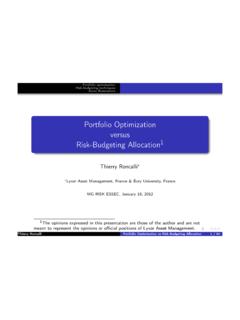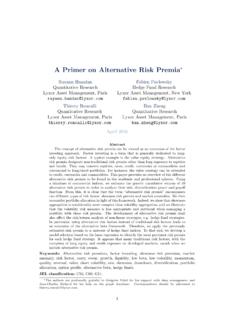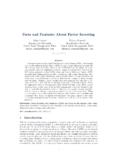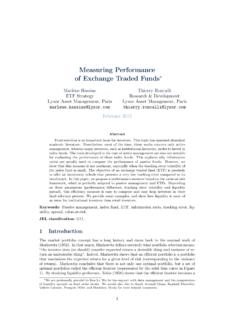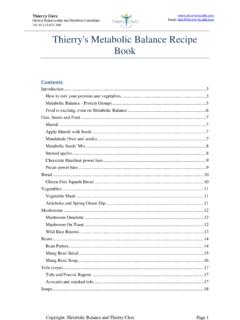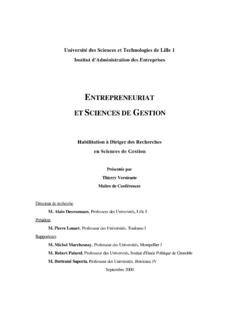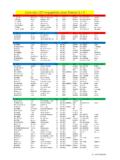Transcription of Risk-BasedIndexation - Thierry Roncalli
1 Risk-Based Indexation . Paul Demey S bastien Maillard Research & Development Research & Development Lyxor Asset Management, Paris Lyxor Asset Management, Paris Thierry Roncalli Research & Development Lyxor Asset Management, Paris March 2010. Abstract A capitalization-weighted index is the most common way to gain access to broad equity market performance. These portfolios are generally concentrated in a few stocks and present some lack of diversification. In order to avoid this drawback or to sim- ply diversify market exposure, alternative indexation methods have recently prompted great interest, both from academic researchers and market practitioners.
2 Fundamen- tal indexation computes weights with regard to economic measures, while risk-based indexation focuses on risk and diversification criteria. This paper describes risk-based indexation methodologies, highlights potential practical issues when implemented, and illustrates these issues as it applies to the Euro Stoxx 50 universe. Keywords: Risk-based indexation, fundamental indexation, market capitalization, equity indexes, diversification, portfolio optimization, robust estimation. JEL classification: G11, C60.
3 1 Introduction For the past forty years, asset allocation has relied on the Capital Asset Pricing Model (CAPM) theory, originated by William F. Sharpe (1964). CAPM theory concludes that under some assumptions, market-capitalization weighting is efficient for asset allocation, in the sense that no other portfolio with the same risk ( volatility) will have a higher expected return. Since then, capitalization-weighted indexes (hereafter CW) have played a central role in the investment industry. First, they provide convenient access to broad equity markets and serve as a natural investment vehicle in financial markets (index funds, electronic-traded funds, derivatives).
4 Second, they represent a reference and benchmark for active management. Realistically, the assumptions of CAPM do not hold (investors do not all have the same expectations, they cannot sell short without a penalty), and CAPM appears to be inefficient We are grateful to Yannick Daniel, Kais Mbarek, Fran ois Millet, Katrin Muller, Pamela Segal and Guillaume Simon for their helpful comments. RISK-BASED INDEXATION. (see, for example, Haugen et al. (1991), Amenc et al. (2006), Hsu (2006)). In this context, investors have recently shown great interest in alternative-weighted indexes (hereafter AW).
5 An alternative-weighted index is defined as an index in which assets are weighted in a different way than those based on market capitalization. Alternative-weighted indexes can be split into two families: fundamental indexes and risk-based indexes. Fundamental indexation defines the weights as a function of economic metrics like dividends or earnings. This indexation has been studied in numerous articles (for example Arnott et al. (2005), Estrada (2008) or Haugen et al. (2010)) and aims to provide higher returns and lower risk than capitalization-weighted indexes.
6 On the other hand, risk-based indexes are meant to diversify the risk of the portfolio. Two well-known examples are the minimum-variance portfolio (or MV portfolio) and the equally- weighted portfolio (or 1/n portfolio). The MV portfolio is located on the mean-variance efficient frontier with the lowest risk. Many equity funds have recently been launched using this concept as it is both easy to compute, due to its unique solution, and recognized as robust, since it is the only one among mean-variance efficient portfolios that does not incorporate any information on expected returns.
7 However, minimum-variance portfolios are generally suffering from and even deepening the drawback of portfolio concentration. A. natural and simple way to deal with this last issue is to attribute the same weight to all the assets of the portfolio. Equally-weighted portfolios are widely used in practice (Bernartzi and Thaler (2001), Windcliff and Boyle (2004)) and have been shown to be efficient in out-of-sample exercises (DeMiguel et al., 2007). Recently, Choueifaty and Coignard (2008). introduced the concept of the most diversified portfolio (or MDP portfolio).
8 As in the case of minimum-variance portfolios (Clarke et al., 2006), the weights of the portfolio depend only on the covariance matrix. Later, Maillard et al. (2008) studied the properties of the equally- weighted risk contributions portfolio (or ERC portfolio) as a new methodology for building a diversified portfolio. All of these methods have contributed to the emergence of the concept of risk-based indexation. The main difference between fundamental and risk-based indexes is that the former promises alpha, whereas the latter promises diversification.
9 This paper, which aims at comparing the different risk-based indexes, is organized in the following structure: Section 2 analyzes the properties of capitalization-weighted and fundamental indexes; Section 3 details the various risk-based indexes (MV, 1/n, MDP/MSR. and ERC portfolios) by comparing them in terms of mathematical properties; Section 4. presents empirical results based on the DJ Euro Stoxx 50 universe over the period 1992- 2009 and Section 5 draws conclusions. 2 Beyond capitalization-weighted indexes Let us consider an index composed of n stocks.
10 Let Pi (t) be the price of the i-th stock and Ri (t) be the corresponding return between time t 1 and t: Pi (t). Ri (t) = 1. Pi (t 1). The value of the index (or benchmark) B (t) at time t is defined by: n X. B (t) = B (t 1) wi (t) (1 + Ri (t)). i=1. Pn where wi (t) is the weight of the i-th stock in the index satisfying i=1 wi (t) = 1. The computation of the value of the index B (t) is generally calculated at the closing time t. 2. RISK-BASED INDEXATION. However, this computation is purely theoretical. In order to replicate this index, we have to build a hedging strategy that consists of investing in stocks.


